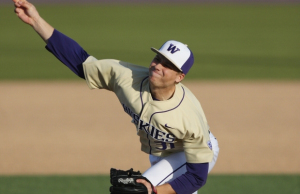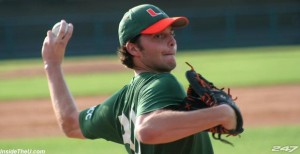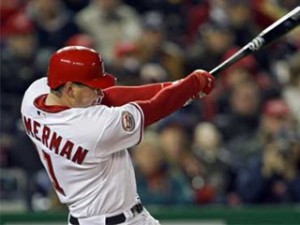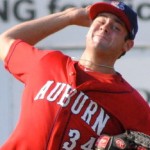
Austin Voth was great last year and has been good this year. Photo via mlbdirt
We’re a month into the minor league season and nearly five turns through each minor league system rotation, so lets take a look to see how our starters are doing.
As with the major league rotation review, I’ve assigned grade letters to roughly judge each start done by our minor league staff, and then i’ve tacked on their overall stats for context. Note that I generally give grades to those that get the starts in games, as well as those who pitch “starter length” outings. You’ll see this much more frequently in the low-A section, where Hagerstown clearly has a “two-starter” system going for many of its guys; one guy will throw 5 innings, then the next guy throws 4. So nearly the entire Hagerstown roster is getting “starter grades” right now. I should also caveat that this analysis is “scouting the box score” analysis; I’ve not had a chance to see any of these guys in person, so I can’t comment on the luck factor involved with anyone (stats versus ability) other than inference analysis between ERA and FIP.
For each team I’ll list the current rotation as best as I can make it, then have a second section where we list the guys with spot-starts or who were in the rotation but are no longer (D/L trips, promoted, demoted, etc). Then we’ll discuss, and then list those guys who are pushing for promotions and those guys who are in jeopardy of getting demoted (or, worse, released).
(Note: I wouldn’t be able to do this data tracking or this post without the great daily work by Luke Erickson at www.nationalsprospects.com.) All stats here are as of 5/2/14, which means I grabbed one May start’s worth of stats for a couple of guys here and there.
AAA/Syracuse:
| Pitcher |
Start Trend Line |
W/L |
ERA |
Whip |
FIP |
K/BB Ratio |
# of innings |
Apps/Starts |
| Roenicke |
A (3ip),F,B |
0-2 |
5.84 |
1.54 |
4.10 |
7/7 |
12 |
5/3 |
| Tatusko |
A/short,B-,B+,A,B |
1-3 |
2.36 |
0.83 |
3.87 |
15/7 |
26.2 |
5/5 |
| Treinen |
A-> upandback,C/short,B+ |
0-0 |
0.87 |
1.16 |
3.58 |
8/5 |
10.1 |
3/3 |
| Hill |
A,A+,C,A,C |
3-1 |
2.35 |
0.91 |
3.68 |
29/4 |
30.2 |
5/5 |
| Poveda |
F,F,A,F |
1-3 |
9.82 |
2.07 |
5.13 |
12/10 |
18.1 |
4/4 |
| Laffey |
A (took Treinen’s spot),A+,D+ |
2-0 |
1.80 |
0.67 |
1.92 |
14/2 |
15 |
3/1 |
| Rosenbaum |
D,A,C-,D/inc (injury)->D/L |
1-1 |
4.50 |
1.35 |
4.18 |
9/5 |
20 |
4/4 |
Rotation Discussion:
A month in and the Syracuse Chiefs are mired in last place (though to be fair, only 3 games separate the entire division). Opening day starter Danny Rosenbaum is already on the D/L with a possible torn UCL, possibly the latest in an epidemic of Tommy John surgeries throughout baseball (there’s been at least 14 MLB pitchers to go under the knife for this already in 2014 and quite a few more minor leaguers; I have a draft post on this topic coming). His replacement in the rotation is journeyman and Ian Desmond-relative Josh Roenicke, who has struggled in his spot-start duties. However, Roenicke isn’t the least effective starter in AAA; that distinction goes to late spring training acquisition Omar Poveda, who has gotten pretty well battered so far in his four starts. One of these two guys likely is making way for recently demoted Taylor Jordan (well, assuming Jordan even makes it to AAA anytime soon; Doug Fister‘s return is complicated by the Nats needing another starter in-between; Jordan likely is sitting in AAA limbo until tuesday 5/6, then will settle into the AAA rotation).
Meanwhile, we’re seeing excellent springs so far out of Ryan Tatusko, Blake Treinen (albeit in a SSS thanks to his being bounced up and down out of the Nats bullpen), Aaron Laffey and especially Taylor Hill. Hill’s excellent 29/4 K/BB ratio stands out, as well as his sub 1.00 whip so far in 5 starts. I think its fair to say that nobody expected him to have rocketed up the system like he has, given the fact that he was a college senior draftee with limited bonus and limited leverage. I think its also worth noting Tatusko’s production in a swing-man role; quite similarly to his trade-mate Tanner Roark, he continues to produce at an advanced/MLFA age … could he be another “found gold” pitcher in our upper farm system?
We should also note that we have yet to see Brad Meyers, who remains on the D/L and has only thrown about 6 professional innings since 2011.
Bullpen Notables
The Syracuse bullpen has seen plenty of traffic to and from the majors: Aaron Barrett started in the majors and has seen time in Syracuse. Ryan Mattheus and Xavier Cedeno have already both been up and back. Nobody in the pen has much more than about 10 innings pitched, so we won’t make too many rash judgements. So far Christian Garcia looks decent; his 12/2 K/BB ratio in 10 innings is promising but he currently sits on the D/L with an unspecified injury. Meanwhile Daniel Stange has struggled with his control; he has 10 walks in 12 innings. We’ll talk more about bullpen guys deeper into the season.
Most Deserving of a promotion: Hill and perhaps Laffey, both of whom are pitching dominantly right now. But neither are 40-man guys, and that (especially for Laffey) hurts him. Laffey as a starter in AAA has been great, but he might be more useful as a lefty-match up guy. Cedeno has been getting the MLB-bullpen covering call-ups but if Laffey was on the 40-man instead, it probably would have been him instead.
Most in Jeopardy of a demotion/release: Poveda for sure; his cash-only acquisition isn’t looking promising considering that a rotation spot is needed soon for Jordan. Roenicke needs a couple of good outings to get his numbers up; with only 12 innings its hard to pass too harsh a judgement. But, with very little push from the current AA rotation, its hard to see a reason why the organization needs to make a move anytime soon (see the next section for more).
AA/Harrisburg:
| Pitcher |
Start Trend Line |
W/L |
ERA |
Whip |
FIP |
K/BB Ratio |
# of innings |
Apps/Starts |
| Schwartz |
F,F,B+,F,D+ |
0-4 |
6.08 |
1.99 |
5.1 |
15/10 |
23.2 |
5/5 |
| Rivero |
D-,B,B-,F,B+ |
1-4 |
5.06 |
1.69 |
4.85 |
13/9 |
21.1 |
5/5 |
| Gilliam |
F,B-,D,A |
0-0 |
5.09 |
1.36 |
6.05 |
13/9 |
17.2 |
5/4 |
| Purke |
F,D,F,F |
0-5 |
9.30 |
2.11 |
6.55 |
14/13 |
20.1 |
5/5 |
| Cole |
B-,A,D,F |
2-1 |
3.63 |
1.57 |
2.82 |
16/4 |
22.1 |
5/5 |
| Dupra |
B+ |
1-0 |
0.00 |
0.9 |
4.35 |
3/3 |
3.1 |
1/0 |
| Perry |
F -> d/l |
0-0 |
5.63 |
1.5 |
3.07 |
6/3 |
8 |
5/0 |
| Jackson |
A -> promoted |
0-0 |
0.00 |
0.52 |
2.01 |
7/0 |
7.2 |
5/0 |
| Bates |
B |
0-0 |
5.68 |
|
1.66 |
2.97 |
12.2 |
6/0 |
Rotation Discussion:
Well, there’s not much joy in Harrisburg in terms of the rotation right now. The team is already 7.5 games out of first and is in dead last in the Eastern League. Four of the five starters in Harrisburg are, well, just awful right now. I should note that the stats above do include one extra start for Matthew Purke; it didn’t help his cause. Newly acquired Felipe Rivero has not acclimated well to Harrisburg, to say the least. Blake Schwartz has not adjusted well to the jump to AA after his excellent season in Potomac last year. The one bright spot seems to be A.J. Cole by ERA/FIP, but he’s still putting an awful lot of people on base (1.57 whip).
Sammy Solis remains on the AA D/L, along with a handful of other long-serving names in this organization (Paul Demny, Rafael Martin and Pat Lehman).
Bullpen Notables
Zach Jackson already earned his promotion via 7 scoreless innings, though to be fair he really should have been in AAA to start (he’s a veteran minor leaguer and has been pitching at the AAA level for nearly a decade). Matt Grace is faring well thus far, as is Richie Mirowski, while Gabriel Alfaro needs to get his control under control (he’s got 9 walks in 11 1/3 innings).
Most Deserving of a promotion: none of these guys are pushing for a promotion, now that Jackson is back in AAA where he belongs.
Most in Jeopardy of a demotion/release: You have to think that Purke may be in jeopardy of being coverted to relief at this point. Alfaro was a MLFA signing out of the Mexican league and may not be long for the organization if he keeps pitching this badly. Gilliam was a throw-in to the Gio Gonzalez trade and is old for the level; he may get pushed out if someone from Potomac makes a case for promotion (which, thankfully for him, has yet to be the case; read on).
High-A/Potomac
| Pitcher |
Start Trend Line |
W/L |
ERA |
Whip |
FIP |
K/BB Ratio |
# of innings |
Apps/Starts |
| Rauh |
B-,F-,C+,C- |
1-1 |
4.43 |
1.57 |
4 |
15/7 |
20.1 |
5/4 |
| Rpena |
F,D,F/inc,A-,A- |
2-0 |
6.43 |
1.48 |
5.71 |
5/8 |
21 |
5/5 |
| Mooneyham |
F,C-,A-,D/short,B- |
2-1 |
3.32 |
1.63 |
6.71 |
7/19 |
19 |
5/4 |
| Bacus |
A+,A+,A (into rotation for Encarnacion) |
1-1 |
2.08 |
0.69 |
4.7 |
15/3 |
17.1 |
6/0 |
| Simms |
(newly promoted; no Apr starts) |
|
|
|
|
|
|
|
| Dickson |
B+,F,B+,A |
0-2 |
6.23 |
1.38 |
5.37 |
21/7 |
21.3 |
7/0 |
| Encarnacion |
C+,B,F,D- ->d/l |
1-2 |
4.00 |
1.94 |
5.88 |
14/12 |
18 |
4/4 |
| Lee |
F-,F-,D,A -> d/l |
0-2 |
10.05 |
1.74 |
2.33 |
23/8 |
14.1 |
5/4 |
| Fister |
B (rehab) |
0-0 |
0.00 |
1.5 |
2.16 |
3/0 |
4 |
1/1 |
| Dupra |
A+,B+,A,A-> promoted |
3-0 |
0.53 |
0.71 |
1.31 |
23/1 |
17 |
5/0 |
Rotation Discussion:
Potomac is sitting in 1st place easily with the rest of its division struggling so far. But Its hard to see how they’re doing it with a rotation putting up numbers like this. The only guy getting starts for Potomac in April with a respectable/impressive FIP was Nick Lee, and he’s on the D/L. But even Lee’s numbers look completely weird: he had a 10 (ten!) ERA in his 14 innings, but an astounding 23 ks in 14 innings. His numbers are completely spiked by two successive awful outings and he currently sits on the D/L with an unspecified but hopefully short-term injury. Dakota Bacus earned his way into the rotation with a series of excellent long-relief outings; he replaces the also-injured opening day rotation starter Pedro Encarnacion, who himself struggled with his control (12 walks in 18 innings) before hitting the D/L. Otherwise there’s not much notable in the Potomac rotation to talk about: Brett Mooneyham‘s advanced numbers show just how bad he’s really pitched; he currently has a 7/19 K/BB ratio in 19 innings. He has more than twice the number of walks as he has strikeouts! That’s not a recipe for success long-term.
Kylin Turnbull remains on the Hagerstown D/L, continuing to be a complete 2011 draft-day disappointment.
Bullpen Notables
The best reliever in Potomac thus far this season has already been bumped up; Brian Dupra posted a nifty 23/1 K/BB ratio and earned his way to AA. Robert Benincasa already has 5 saves with good numbers. Derek Self has great numbers and has given up just three base-runners in 10 innings thus far. So the Nats are getting some great relief. Gilberto Mendez hasn’t walked a guy yet and is one of the youngest guys in the league, so he’s clearly holding his own after posting a 0.91 ERA in low-A last year.
Most Deserving of a promotion: Outside of Dupra, its hard to pinpoint someone that really is pushing for a promotion out of this squad right now. Bacus is pitching well but he’s just got a month of high-A experience; lets see how he does for a half season. I could see the late-inning crew of Self, Benincasa and Bryan Harper possibly getting moved up sooner than later. But none of the starters really are making a case for promotion right now.
Most in Jeopardy of a demotion/release: Clearly for me the guy in trouble is Mooneyham; you just can’t be walking that many guys and have as little swing-and-miss capabilities to counter-balance your wildness. Before his injury, Encarnacion was struggling with his command too; I can see him back in low-A. Lastly Ronald Pena just is not fooling anybody right now; he’s got just 5 Ks in 20 innings and would be in more jeopardy if there weren’t other candidates ahead of him to replace at this point.
Low-A/Hagerstown
| Pitcher |
Start Trend Line |
W/L |
ERA |
Whip |
FIP |
K/BB Ratio |
# of innings |
Apps/Starts |
| Pivetta |
A,A-,F,F,B+ |
3-2 |
4.57 |
1.48 |
4.36 |
13/10 |
21.2 |
5/5 |
| Voth |
A,D,A-,D/short |
0-2 |
2.91 |
1.38 |
2.7 |
26/10 |
21.1 |
5/5 |
| Giolito |
D-,A+,A,C-,C- |
1-0 |
2.95 |
1.22 |
3.62 |
24/11 |
21.1 |
5/5 |
| Anderson |
A,A+,F,D- |
3-0 |
6.33 |
1.36 |
4.98 |
13/6 |
21.1 |
5/3 |
| Johansen |
B,B+,F,C- |
2-0 |
5.21 |
1.53 |
3.84 |
17/11 |
19 |
4/4 |
| Suero |
D,A,B,A |
3-0 |
1.20 |
0.88 |
3.53 |
13/2 |
21.2 |
5/0 |
| Cooper |
B,A+,D |
2-0 |
2.81 |
1.31 |
2.57 |
11/1 |
16 |
5/0 |
| Jthomas |
A+,A- |
1-2 |
2.53 |
1.22 |
4.51 |
4/5 |
10.2 |
5/0 |
| Ullmann |
B+ |
0-0 |
0.00 |
0.8 |
2.67 |
9/2 |
10 |
4/0 |
| Hollins |
A- |
2-0 |
4.35 |
1.74 |
3.86 |
9/7 |
10.1 |
8/0 |
| Silvestre |
B+,inc (inj)->d/l |
0-0 |
3.00 |
1.33 |
2.24 |
7/2 |
6 |
2/2 |
| Simms |
A,A,A,A+->promoted |
0-0 |
0.98 |
0.82 |
2.05 |
20/2 |
18.1 |
5/0 |
| Spann |
B+,A-,B+,B+->promoted |
2-0 |
1.20 |
1.13 |
2.77 |
15/4 |
15 |
4/0 |
Rotation Discussion:
Hagerstown is taking the South Atlantic league by storm, leading its division by 5.5 games already. And they’re getting some great pitching. The team clearly seems to be doing “combo starts” with some of its guys: that’s why someone like Wander Suero has as many IP as the 5 guys in the “rotation.” So, when it comes to judging starts nearly the entire staff in Hagerstown has “start length” outings to assign grades to. I like what I see out of Austin Voth so far, and Lucas Giolito is clearly holding his own in full-season ball (both these guys feature more than a K/inning, which is great to see especially out of the undersized Voth). Meanwhile we’re seeing some worrying wildness out of Jake Johansen, which will not quell the “he’s too big to be a starter so he’s destined for the bullpen” crowd.
Bullpen Notables
John Simms (11th rounder in 2012) and Matthew Spann (booty for the team’s sticking its nose into the David DeJesus waiver situation last year) have both already forced promotions thanks to excellent results. Otherwise there really isn’t much in the way of a traditional “bullpen” in Hagerstown to talk about.
Most Deserving of a promotion: I’d say Voth and Jake Walsh, who older guys who are mowing guys down in Low-A and may need to be challenged by better/older hitters.
Most in Jeopardy of a demotion: One of the older guys on this staff (Dixon Anderson) isn’t putting up the numbers he needs to be putting up as a college senior 2011 draftee in low-A. Youngster Nicholas Pivetta is also struggling with the jump to full-season ball out of JuCo and may be dumped back to XST at some point. But it should also be said that we’re kind of squinting for bad performances out of the Low-A squad; both these guys’ numbers are better than practically anyone in AA right now.
Top Prospect Review
From a trending perspective for our top 10 prospect arms (in rough order of their typical rankings on prospect lists):
- Giolito is succeeding so far, though isn’t as dominant yet to be pushing for a promotion to High-A
- Cole is holding his own and is the best AA starter right now, but again isn’t entirely pushing for a AAA promotion just quite yet.
- Solis has yet to appear thanks to a late spring training injury.
- Rivero has really struggled since his arrival
- Johansen has shown some wildness and not as much swing-and-miss stuff as he did in short-season ball.
- Purke has been awful and it may be time to move him to the Pen.
- Voth has been excellent and is probably the closest to a promotion.
- Barrett and Treinien have both earned promotions to provide MLB cover, and when in AAA have been effective
- Jefry Rodriguez is in XST and didn’t make a full-season team.
Conclusions:
So far, I must say i’m a bit disappointed in the performance of the AA squad, but its great to see the promise of the Low-A squad. I’m slightly worried about how our closer-to-the-majors top prospect arms are looking; lets re-visit in a month and see how it looks.







